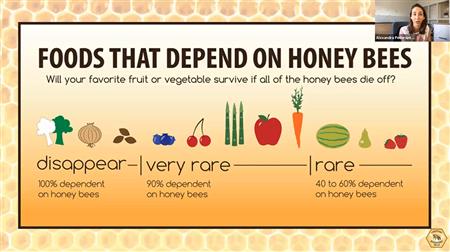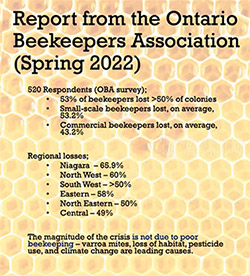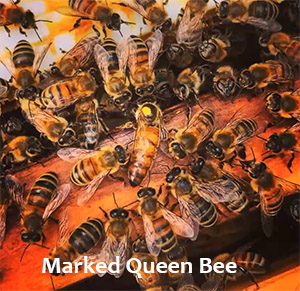
Dr. Pedersen began by saying she could drone on for hours (beekeeper joke) and provided an update on the state of the bees in Ontario and nationally.
This past winter was tough on bees, having a die off of 60% locally and 53% across the over 100,000 colonies in Ontario. This will take more than one year to recover. Pesticides, mite infestations, climate change, and urban sprawl are all contributing factors to the deaths.

Humans need bees to pollenate 70% of the foods we eat, so there will be a significant loss of food security and diversity if the bees disappear.
There are several ways to help the bees: use fewer pesticides and let your grass grow; buy local honey to support local beekeepers; plant pollinator-friendly gardens; support honey bee research; and become a beekeeper yourself.
The Limestone Beekeepers' Guild emphasizes learning and experience of beekeepers. While they support all local pollinators, not just bees, the European honeybee is the bee of choice.
New beekeepers start with 2 or 3 hives with small scale apiaries having 1 to 50 hives.
She showed us the Longstroth Hive, which is the perfect box for growing honeybees and producing honey, explained how smokers work, and explained to us her tools: brush, comb, veil and 3 layered protective suit.
Hives may well have up to 80,000 workers and drones.
Queens can live up to 7 years but 2 is normal. Each hive is populated by only 1 Queen, which lays up to 1500 eggs per day. Specialized cells are created for growing new queens, and the hive will usurp their own queen if they're unhappy with her production rate.
 Queens are unique and individual in appearance with long bodies to accommodate the eggs. As queens are difficult to visually distinguish from workers, beekeepers mark their queen bees with a coloured dot on the abdomen (determined each year by the Honey Council of Canada) to make her easier to find.
Queens are unique and individual in appearance with long bodies to accommodate the eggs. As queens are difficult to visually distinguish from workers, beekeepers mark their queen bees with a coloured dot on the abdomen (determined each year by the Honey Council of Canada) to make her easier to find. All the worker bees are female. These travel up to 5km away from the hive and can fly at 24 kph. Living approximately 6 weeks, they do all the work and when they sting they produce a pheromone that attracts more bees to sting.
Bees can carry their weight in nectar, but landing when fully laden is a challenge.
Guard bees check their pheromones to prevent foreign bees and intruders from entering the colony.
The drone bees are the only males in the hive. Drone bees cannot sting. Their entire role is to mate with queens and are expendable so are "excommunicated" in the winter.
If they don't have enough stores for the winter, bees will rob neighbouring hives of their honey, which can destroy smaller hives, so beekeepers have to ensure there is enough food for winter. Over the winter, bees crowd around their queen and vibrate to keep her and the hive warm. In colder climates, some beekeepers augment this natural mechanism by wrapping them in insulation or hay bales. They are currently experimenting with placing hives in indoor storage trailers or in barns.
Limestone Beekeepers' Guild Facebook group accepts callouts for swarm sightings to have a beekeeper come to collect them.
Watch and Listen to Dr Alexandra Pedersen's Talk
If you like this news story and video please check the like button and share it using your favourite social media channel.


